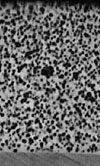Nickel plating
 Nickel plating is a common process, but there are two main methods of producing a thin layer of nickel on the surface of a metallic object. The first is to use a traditional electroplating process whereby the parts to be plated are part of an electric circuit and form the cathodes. A rod of the plating metal is used as an anode. These are immersed into a bath of electrolyte commonly containing a salt of the metal to be plated. In the case of nickel plating, the salt used is Nickel Chloride. Quite often with electroplating, there are two or even three plating processes used for the best results, with an underlying electroplated layer of a different metal being used. The reason for this is to improve adhesion.
Nickel plating is a common process, but there are two main methods of producing a thin layer of nickel on the surface of a metallic object. The first is to use a traditional electroplating process whereby the parts to be plated are part of an electric circuit and form the cathodes. A rod of the plating metal is used as an anode. These are immersed into a bath of electrolyte commonly containing a salt of the metal to be plated. In the case of nickel plating, the salt used is Nickel Chloride. Quite often with electroplating, there are two or even three plating processes used for the best results, with an underlying electroplated layer of a different metal being used. The reason for this is to improve adhesion.
Quite often, most especially for high-strength steels, there is a serious disadvantage to electroplating, and that is the phenomenon of hydrogen embrittlement. Hydrogen gas is liberated at the surface of the cathode, i.e. the part to be plated, and this rapidly diffuses into the surface of the part, causing it to become brittle. This can be overcome by the use of a low-temperature post-plating heat treatment process which reverses the process of hydrogen diffusion into the surface layers. As an unqualified engineer some years ago, I was unaware of hydrogen embrittlement, and decided to send some motorcycle parts to be made pretty with zinc. I was soon to discover the error of my ways when my side-stand spring broke very soon afterwards. The same mistake is very often made on a much more grand scale.
The second method of plating with nickel is known as electroless nickel plating, and as the name suggests, it does not rely on an applied electric current, but is a chemical reaction. It has an advantage in that the parts to be plated do not need to be electrically conductive, and so the process can be used on polymers, composites and ceramics etc. It is quite widely used to produce prototype representations of metallic parts by plating something made from polymer castings or parts produced by rapid prototype methods. Parts treated with electroless nickel platings have been known to suffer from hydrogen embrittlement and so for cyclically stressed parts, we need to take the same precautions as we would for parts using an electroplating process. The post-plate heat treatment is considered to improve adhesion of electroless nickel; the reason for this is felt to be reduction of internal stresses within the deposited nickel. It is possible to heat-treat the nickel plating to produce a very hard surface, but you must be careful that the heat-treatment does not otherwise compromise the existing material, i.e. by temper-softening it.
There are a number of variations on electroless nickel, and some coatings which are described as 'composite' coatings. These don't refer to the substrate, but to the face that it is possible to have embedded in the nickel matrix particles of other materials. There are a number of electroless nickel treatments which have additions of PTFE (Teflon) added for lower friction and several with ceramic particulate reinforcements, such as zirconia and silicon carbide. Although probably very expensive, electroless nickel composite platings containing industrial diamonds show good promise as wear resistant coatings. The accompanying picture shows the microstructure of an electroless nickel composite containing diamond.
Fig. 1 - Microstructure of an electroless nickel composite containing diamond.
Written by Wayne Ward